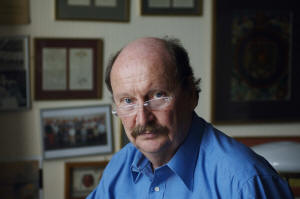Professor Edzard Ernst
The NewScientist article Interview: The complementary medicine detective said
When Edzard Ernst became the UK’s first professor of complementary medicine, he was attacked by both alternative therapists and conventional doctors. The doctors have come round, but he is now alternative medicine’s public enemy number one after sticking the needle into everything from acupuncture to homeopathy. He insists he is just being a good scientist, but it has been a long journey for someone whose family doctor was a homeopath. Michael Bond hears him out
You have published about 1000 articles on the safety and efficacy of alternative medicine. What have you found that is positive?
What we’ve found is that about 5 per cent of alternative therapies are backed up by evidence. There is good evidence for the effectiveness of some herbal remedies, such as St John’s wort in treating mild to moderate depression, and devil’s claw for musculoskeletal pain or hawthorn for heart failure. Acupuncture works for certain things. Traditional acupuncturists will say you can use it for everything, but the evidence suggests it works only for some pain conditions and for nausea and vomiting. Other evidence-based treatments include hypnosis for pain, music therapy for anxiety, and relaxation for insomnia.
Edzard Ernst, MD, PhD, FRCP, FRCPEd is
Laing Chair in Complementary Medicine, University of Exeter.
He is founder/Editor-in-Chief of two medical journals (Perfusion and
FACT).
He has published more than 40 books and in excess
of 1,000
articles in peer-reviewed medical literature and has been given
visiting professorships in Canada and the US. His work has been awarded
with 13 scientific prizes.
Edzard is Editor or Member of the Editorial Board of about 30 medical
journals
including:
- Angiology (Associate Editor)
- BMC Complementary Alternative Medicine (Ed Board)
- BMC Medicine (Ed Board)
- Climacteric (Ed Board)
- Current Drug Safety (Ed Board)
- Focus on Alternative and Complementary Therapies (Editor in Chief)
- Journal Pain Symptom Management (Ed Board)
- Journal Society Integrated Oncology (Ed Board)
- Münchner Medizinische Wochenschrift (Co-Editor)
- Perfusion (Editor in Chief)
- Phytomedicine (Ed Board)
- PLoS Medicine (Ed Board)
- Supportive Care in Cancer (Ed Board)
- Wiener Medizinische Wochenschrift (Ed Board)
His papers include Fibrinogen as a Cardiovascular Risk Factor, The Risk—Benefit Profile of Commonly Used Herbal Therapies: Ginkgo, St. John’s Wort, Ginseng, Echinacea, Saw Palmetto, and Kava, The Efficacy of “Distant Healing”: A Systematic Review of Randomized Trials, Garlic for Treating Hypercholesterolemia: A Meta-Analysis of Randomized Clinical Trials, Different standards for reporting ADRs to herbal remedies and conventional OTC medicines: face-to-face interviews with 515 users of herbal remedies, Adverse events following acupuncture: prospective survey of 32,000 consultations with doctors and physiotherapists, and A systematic review of herbal medicinal products for the treatment of menopausal symptoms.
Edzard qualified in 1978 as a physician in Munich (Germany) where he also completed his MD and PhD theses. In 1988, he became Professor in Physical Medicine and Rehabilitation (PMR) at Hannover Medical School (Germany) and in 1990 Head of the PMR Department at the University of Vienna (Austria). His remit in Vienna was to build up a large rehabilitation unit to serve the then newly constructed “Allgemeines Krankenhaus” with more than 2,000 beds. During his 4 years in Vienna, he extended the pre-existing unit of about 20 staff to a department with 100 employees. His department was the first clinical unit to move into the new hospital.





